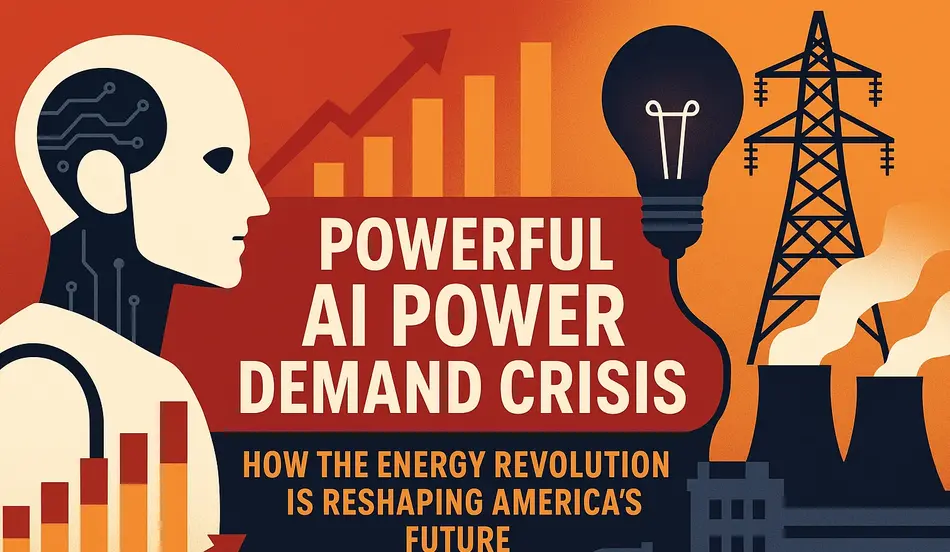Introduction: The AI Power Demand Energy Crisis That’s Reshaping Everything
The United States is facing an unprecedented AI power demand energy crisis that’s fundamentally changing how we think about energy production, consumption, and innovation. As artificial intelligence workloads continue to surge, the energy requirements are reaching levels that were unimaginable just a few years ago. This crisis isn’t just about keeping the lights on—it’s about powering the future of technology while maintaining America’s competitive edge in the global AI race.
The numbers are staggering: data centers could consume up to 12% of total U.S. power by 2028, up from less than 4% in 2022. This dramatic increase has forced tech giants, energy companies, and policymakers to rethink everything from nuclear power to hydrogen fuel cells. The AI power demand energy crisis is creating both challenges and opportunities that will define the next decade of American innovation.
The Scale of the AI Power Demand Energy Crisis
Understanding the Numbers Behind the Crisis
The AI power demand energy crisis is driven by several converging factors that have created a perfect storm in the energy sector:
- Data Center Explosion: Microsoft, Meta, Google, and Amazon spent a combined $125 billion on data centers in 2024 alone
- Power Consumption Surge: AI data center power demand is rising 15-20% every year through 2030
- Household Equivalent: A single 100MW data center consumes as much energy as 100,000 U.S. households
- Grid Strain: Traditional power infrastructure is struggling to keep up with the exponential growth
The crisis has become so severe that some utilities are reconsidering plans to close coal-fired power plants, while others are racing to build new nuclear facilities and hydrogen-powered data centers.
The DeepSeek Factor: Efficiency vs. Demand
China’s recent DeepSeek breakthrough added a new dimension to the AI power demand energy crisis. While the more efficient models raised questions about whether power demand would continue surging, industry experts believe it will actually accelerate adoption:
- Efficiency Paradox: More efficient AI models often lead to increased usage and demand
- Copycat Effect: Other companies will adopt similar efficiency improvements
- Demand Acceleration: Rather than reducing power needs, efficiency improvements may create more demand sooner
This creates a complex dynamic where technological advances in AI efficiency don’t necessarily solve the underlying AI power demand energy crisis—they may actually intensify it.
Related Post: Explore Top Jobs on WhatJobs
Looking to capitalize on the AI power demand energy crisis? Discover thousands of opportunities in the energy sector—from nuclear engineering to hydrogen innovation. Whether you’re starting out or scaling up your career, the energy revolution is full of high-growth potential.
- Explore AI and Energy Jobs on WhatJobs
- Find Nuclear Engineering Positions
- Discover Renewable Energy Careers
Revolutionary Energy Solutions Emerging from the Crisis
Hydrogen-Powered Data Centers: The Future Is Here
In Silicon Valley, companies like ECL are demonstrating that hydrogen-powered data centers aren’t just science fiction—they’re operational reality. The AI power demand energy crisis has accelerated development of these innovative solutions:
- Off-Grid Operation: ECL’s hydrogen-powered data center runs completely off-grid
- Zero Emissions: Advanced hydrogen systems can achieve near-zero emissions
- Cost Efficiency: Hydrogen power costs have dropped to $0.06 per kilowatt hour
- Scalability: Plans for 1-gigawatt hydrogen data centers are already in development
The hydrogen revolution represents one of the most promising solutions to the AI power demand energy crisis, with major investments from tech giants and government support.
Nuclear Renaissance: Small Modular Reactors Take Center Stage
The AI power demand energy crisis has sparked a nuclear renaissance, with companies like Last Energy developing small modular reactors (SMRs) specifically for data centers:
- Modular Design: 20MW units that can be deployed directly at data center sites
- Safety Improvements: Advanced containment systems and passive safety features
- Commercial Viability: 80 commercial agreements already signed for AI data centers
- Timeline: First SMRs scheduled to come online in 2027
Nuclear power offers the reliability and scalability needed to address the AI power demand energy crisis, with companies like Microsoft restarting mothballed nuclear plants to meet growing demand.
Fusion Power: The Holy Grail of Clean Energy
Companies like Helion are pushing the boundaries of fusion technology to solve the AI power demand energy crisis:
- Microsoft Partnership: Signed agreement to buy fusion power for Washington state data centers by 2028
- Cost Targets: Aiming for fusion power at just a few cents per kilowatt hour
- Commercial Timeline: Polaris prototype came online in December, targeting electricity generation
- Investment Backing: $375 million investment from OpenAI CEO Sam Altman
While fusion remains ambitious, the AI power demand energy crisis has created unprecedented urgency and funding for these breakthrough technologies.
The Economic Impact of the AI Power Demand Energy Crisis
Investment Boom in Alternative Energy
The AI power demand energy crisis has triggered an investment boom that’s reshaping the energy sector:
- Nuclear Investments: Amazon’s $500 million investment in small nuclear reactor projects
- Fusion Funding: Hundreds of millions invested in fusion and fission technologies
- Hydrogen Development: Major investments in green hydrogen infrastructure
- Geothermal Expansion: Google’s partnership with Fervo Energy for geothermal data centers
This investment surge is creating thousands of new jobs and opportunities across the energy sector, from engineering to operations to research and development.
Job Market Transformation
The AI power demand energy crisis is creating unprecedented opportunities for job seekers:
- Nuclear Engineers: High demand for SMR and fusion reactor specialists
- Hydrogen Technicians: Growing need for hydrogen fuel cell and infrastructure experts
- Data Center Operators: Expanding opportunities in energy-efficient facility management
- Renewable Energy Specialists: Increased demand for solar, geothermal, and wind experts
The crisis is not just about energy—it’s about creating a new generation of energy professionals who can build and operate the infrastructure of the future.
Government Response and Policy Implications
Federal Support and Regulatory Changes
The AI power demand energy crisis has prompted significant government action:
- Biden Administration: $7 billion awarded for clean hydrogen hubs
- Trump Administration: Stargate initiative with up to $500 billion for AI infrastructure
- Tax Credits: Major tax incentives for clean hydrogen and renewable energy
- Regulatory Streamlining: Faster permitting for energy infrastructure projects
The policy response to the AI power demand energy crisis reflects its national security and economic importance.
Environmental Considerations
The AI power demand energy crisis has created a complex environmental dynamic:
- Carbon Emissions: Data center emissions rose 29-50% from 2019-2023
- Renewable Goals: Tech companies’ carbon-free pledges becoming harder to achieve
- Transition Challenges: Coal plant closures being reconsidered due to power needs
- Clean Energy Push: Renewed focus on scalable, affordable clean energy solutions
Balancing energy needs with environmental goals remains one of the biggest challenges of the AI power demand energy crisis.
The Global Competition for Energy Leadership
China’s Aggressive Energy Strategy
The AI power demand energy crisis has become a key battleground in global competition:
- Nuclear Fusion: China breaking records and outpacing U.S. government spending
- DeepSeek Efficiency: Demonstrating technological leadership in AI efficiency
- Energy Infrastructure: Massive investments in next-generation power solutions
- Strategic Positioning: Using energy innovation as a competitive advantage
China’s approach to the AI power demand energy crisis highlights the strategic importance of energy leadership in the AI era.
America’s Response and Competitive Position
The United States is responding to the AI power demand energy crisis with unprecedented investment and innovation:
- Private Sector Leadership: Tech giants leading the charge in alternative energy
- Government Partnership: Federal support for critical energy infrastructure
- Innovation Ecosystem: Strong startup and research community driving breakthroughs
- Market-Driven Solutions: Competitive market forces accelerating development
America’s response to the AI power demand energy crisis will determine its position in the global AI race.
What the AI Power Demand Energy Crisis Means for Your Career
Emerging Job Opportunities
The AI power demand energy crisis is creating exciting new career paths:
- Energy Data Scientists: Analyzing power consumption patterns and optimization
- Nuclear Fusion Engineers: Developing next-generation fusion reactors
- Hydrogen Infrastructure Specialists: Building and maintaining hydrogen fuel systems
- AI Energy Optimizers: Creating algorithms to maximize energy efficiency
These roles offer competitive salaries and the opportunity to work on cutting-edge technology that will shape the future.
Skills for the Energy Revolution
To succeed in the AI power demand energy crisis job market, consider developing these skills:
- Nuclear Engineering: Understanding of fission and fusion technologies
- Hydrogen Systems: Knowledge of fuel cell technology and infrastructure
- Data Center Operations: Expertise in energy-efficient facility management
- Renewable Energy: Familiarity with solar, geothermal, and wind systems
- AI and Machine Learning: Understanding of AI workloads and power optimization
The crisis is creating demand for professionals who can bridge the gap between AI and energy systems.
Frequently Asked Questions About the AI Power Demand Energy Crisis
What is the AI power demand energy crisis?
The AI power demand energy crisis refers to the unprecedented surge in energy consumption driven by artificial intelligence workloads, particularly in data centers. This crisis is characterized by rapidly increasing power demands that are straining existing energy infrastructure and requiring innovative solutions.
How is the AI power demand energy crisis affecting data centers?
The AI power demand energy crisis is forcing data centers to consume massive amounts of energy, with a single 100MW facility using as much power as 100,000 households. This has led to increased costs, infrastructure challenges, and a race to develop more efficient and sustainable power solutions.
What solutions are being developed to address the AI power demand energy crisis?
Solutions to the AI power demand energy crisis include hydrogen-powered data centers, small modular nuclear reactors, fusion power technology, geothermal energy systems, and advanced solar solutions. These innovations aim to provide reliable, scalable, and environmentally friendly power for AI workloads.
How will the AI power demand energy crisis impact job opportunities?
The AI power demand energy crisis is creating thousands of new job opportunities in nuclear engineering, hydrogen technology, renewable energy, data center operations, and energy optimization. This crisis is driving unprecedented investment in the energy sector and creating demand for skilled professionals.
Conclusion: Embracing the Energy Revolution
The AI power demand energy crisis represents both a challenge and an opportunity. While it’s straining existing energy infrastructure, it’s also driving unprecedented innovation and investment in alternative energy solutions. From hydrogen-powered data centers to fusion reactors, the crisis is accelerating the development of technologies that could transform how we produce and consume energy.
For job seekers, the crisis offers exciting opportunities to work on cutting-edge technology that will shape the future. For employers, it represents a chance to lead the energy revolution and build the infrastructure of tomorrow. The AI power demand energy crisis isn’t just about keeping the lights on—it’s about powering the future of innovation and maintaining America’s competitive edge in the global AI race.
The energy revolution is here, and those who embrace it will be the architects of tomorrow’s power infrastructure. Whether you’re an engineer, technician, or business leader, the AI power demand energy crisis offers a chance to be part of something truly transformative.




